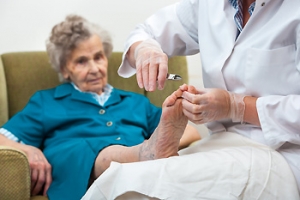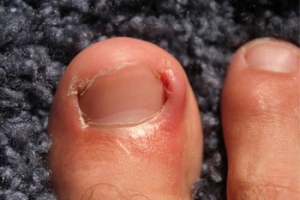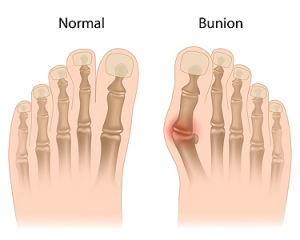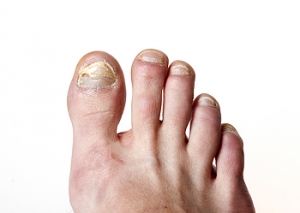Featured Articles

Foot Conditions Resulting from Aging Feet
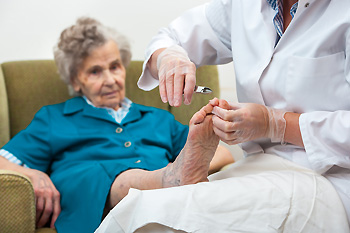 Research has shown that the feet of elderly people may develop foot conditions as the aging process occurs. This may be a result of a loss of cushioning that is found in the feet, in addition to changes in the toenails and skin. It’s important to wear shoes that are comfortable and fit properly, which may include eliminating high heels or shoes that have inadequate room for the toes to move about in. Circulation may improve when gentle foot stretches are performed throughout the day, in addition to wearing socks that are not too tight. There are several common ailments that may be prevalent to aging feet, including Athlete’s foot, cracked heels, and the formation of corns and calluses. Many seniors may become afflicted with the uncomfortable condition known as ingrown toenails, which may be a result of the toenails being cut improperly. Please consult with a podiatrist about effective techniques to properly care for elderly feet.
Research has shown that the feet of elderly people may develop foot conditions as the aging process occurs. This may be a result of a loss of cushioning that is found in the feet, in addition to changes in the toenails and skin. It’s important to wear shoes that are comfortable and fit properly, which may include eliminating high heels or shoes that have inadequate room for the toes to move about in. Circulation may improve when gentle foot stretches are performed throughout the day, in addition to wearing socks that are not too tight. There are several common ailments that may be prevalent to aging feet, including Athlete’s foot, cracked heels, and the formation of corns and calluses. Many seniors may become afflicted with the uncomfortable condition known as ingrown toenails, which may be a result of the toenails being cut improperly. Please consult with a podiatrist about effective techniques to properly care for elderly feet.
Proper foot care is something many older adults forget to consider. If you have any concerns about your feet and ankles, contact one of our podiatrists from Romeo Foot & Ankle Clinic. Our doctors can provide the care you need to keep you pain-free and on your feet.
The Elderly and Their Feet
As we age we start to notice many changes in our body, but the elder population may not notice them right away. Medical conditions may prevent the elderly to take notice of their foot health right away. Poor vision is a lead contributor to not taking action for the elderly.
Common Conditions
- Neuropathy – can reduce feeling in the feet and can hide many life-threatening medical conditions.
- Reduced flexibility – prevents the ability of proper toenail trimming, and foot cleaning. If left untreated, it may lead to further medical issues.
- Foot sores – amongst the older population can be serious before they are discovered. Some of the problematic conditions they may face are:
- Gouging toenails affecting nearby toe
- Shoes that don’t fit properly
- Pressure sores
- Loss of circulation in legs & feet
- Edema & swelling of feet and ankles
Susceptible Infections
Diabetes and poor circulation can cause general loss of sensitivity over the years, turning a simple cut into a serious issue.
If you have any questions please feel free to contact our offices located in Washington and Shelby Townships, MI . We offer the newest diagnostic and treatment technologies for all your foot and ankle needs.
Elderly Foot Care
As you grow older, you will start to notice more problems with your feet due to wear and tear. This may also happen because the skin will start to become thin and lose elasticity. Some signs of aging feet are regular aches and pains, bunion development, and clawed toes.
Fortunately, there are ways you can improve comfort, relieve pain, and maintain mobility in your feet. One of the best ways to deal with aging feet is to exercise. If you keep active, your muscles will become toned which will then strengthen the arches in the foot and stimulate blood circulation.
It is important that you practice proper foot care to protect your aging feet. You should wash your feet in warm water on an everyday basis. Afterward, the feet need to be dried well and it is important to dry between the toes. Your toenails should be trimmed and kept under control; nails that are poorly cut may become ingrown. At the end of each day, performing an inspection of your feet will allow you to detect any ailments in their early stages.
As you grow older, it becomes more important that you wear comfortable shoes. Your shoes should be secure, and they should provide decent arch support. If you are looking to buy a new pair of shoes, it is best to look for a pair that are made from a breathable material. It is also helpful to have shoes that have a bit of extra room at the top of the shoe, especially if you suffer from swollen feet.
The most common foot problems that elderly people will encounter are bunions, calluses, corns, hammertoes, heel pain, and foot problems related to diabetes. Some other issues include arch pain, tarsal tunnel syndrome, Achilles tendonitis, and Morton’s neuroma
An annual foot examination is a great way for you to ensure that you do not have any serious health problems with your feet. You should talk to a podiatrist about the available treatment options for whichever foot issue you are dealing with.
What Causes An Ingrown Toenail?
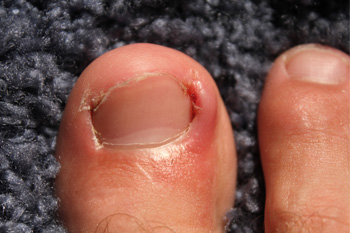 If you are experiencing pain and swelling surrounding the nail on the big toe, you may have what is known as an ingrown toenail. Research has shown that when this condition is treated promptly and correctly, many unpleasant and uncomfortable foot conditions may be avoided. These may include a painful infection developing, as well as partial or total removal of the toenail. There are several causes of why this ailment may occur, including improperly cut toenails, wearing shoes and socks that may be too tight, or possible injuries to the toe. Additionally, genetics may play a role in determining the shape of the toenail, which may press more easily into the side of the toenail. Painful symptoms may include bleeding or discharge from the surrounding area of the toenail, severe redness, or swelling. It’s advised to consult with a podiatrist as quickly as possible so the correct treatment options may be discussed.
If you are experiencing pain and swelling surrounding the nail on the big toe, you may have what is known as an ingrown toenail. Research has shown that when this condition is treated promptly and correctly, many unpleasant and uncomfortable foot conditions may be avoided. These may include a painful infection developing, as well as partial or total removal of the toenail. There are several causes of why this ailment may occur, including improperly cut toenails, wearing shoes and socks that may be too tight, or possible injuries to the toe. Additionally, genetics may play a role in determining the shape of the toenail, which may press more easily into the side of the toenail. Painful symptoms may include bleeding or discharge from the surrounding area of the toenail, severe redness, or swelling. It’s advised to consult with a podiatrist as quickly as possible so the correct treatment options may be discussed.
Ingrown toenails can become painful if they are not treated properly. For more information about ingrown toenails, contact one of our podiatrists of Romeo Foot & Ankle Clinic. Our doctors can provide the care you need to keep you pain-free and on your feet.
Ingrown Toenails
Ingrown toenails occur when a toenail grows sideways into the bed of the nail, causing pain, swelling, and possibly infection.
Causes
- Bacterial infections
- Improper nail cutting such as cutting it too short or not straight across
- Trauma to the toe, such as stubbing, which causes the nail to grow back irregularly
- Ill-fitting shoes that bunch the toes too close together
- Genetic predisposition
Prevention
Because ingrown toenails are not something found outside of shoe-wearing cultures, going barefoot as often as possible will decrease the likeliness of developing ingrown toenails. Wearing proper fitting shoes and using proper cutting techniques will also help decrease your risk of developing ingrown toenails.
Treatment
Ingrown toenails are a very treatable foot condition. In minor cases, soaking the affected area in salt or antibacterial soaps will not only help with the ingrown nail itself, but also help prevent any infections from occurring. In more severe cases, surgery is an option. In either case, speaking to your podiatrist about this condition will help you get a better understanding of specific treatment options that are right for you.
If you have any questions please feel free to contact our offices located in Washington and Shelby Townships, MI . We offer the newest diagnostic and treatment technologies for all your foot and ankle needs.
Ingrown Toenails
An ingrown toenail is a nail that has curved downward and grown into the skin. This typically occurs at either the nail borders or the sides of the nail. As a result, pain, redness, swelling, and warmth may occur in the toe. If a break in the skin forms due to the ingrown nail, bacteria may enter and cause an infection in the area; this is typically characterized by a foul odor and drainage.
Ingrown toenails have multiple reasons for developing. In many instances, the condition is a result of genetics and is inherited. The most common cause, however, is improper trimming; cutting the toenails too short forces the skin beside the nail to fold over. An ingrown toenail can also develop due to trauma, such as stubbing the toe, having an object fall on the toe, or participating in activities that involve repeated kicking or running. Wearing shoes that are too tight or too short can also cause ingrown toenails.
Treatment for an ingrown toenail varies between patients and the severity of the condition. In most cases, it is best to see your podiatrist for thorough and proper treatment. After examining your toe, your podiatrist may prescribe oral antibiotics to clear the infection if one is present. Surgical removal of either a portion of the nail or the entire nail may also be considered. In some cases, complete removal or destruction of the nail root may be required. Most patients who undergo nail surgery experience minimal pain afterward and can return to normal activity the following day.
Ingrown toenails can be prevented with proper nail trimming and by avoiding improper-fitting shoes. When cutting the toenails, be sure that you are cutting in a straight line and avoid cutting them too short. Shoes should not be too short or tight in the toe box.
Treatment Options For Bunion
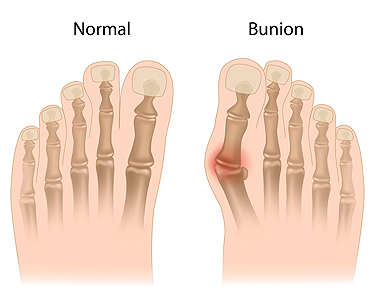 The medical condition known as hallux valgus is commonly referred to as a bunion. It typically occurs as a result of a misalignment in the joint of the big toe, and may cause pain and discomfort. It appears as a large bony protrusion on the side of the big toe and may be difficult to wear specific shoes. If you have a bunion, you most likely may notice tenderness and swelling around the affected joint, in addition to possible joint pain arising from the development of arthritis. This may develop at a faster rate if the bunion is not treated promptly. Some of the reasons why bunions could form may include having an abnormal foot structure such as flat feet, an inherited genetic trait, or extremely flexible ligaments and tendons. Research has shown there are different treatment techniques, which may provide moderate relief. This includes wearing shoes that fit correctly, performing gentle exercises, or wearing insoles in the shoes. It’s important to consult with a podiatrist who can determine the best treatment option for you.
The medical condition known as hallux valgus is commonly referred to as a bunion. It typically occurs as a result of a misalignment in the joint of the big toe, and may cause pain and discomfort. It appears as a large bony protrusion on the side of the big toe and may be difficult to wear specific shoes. If you have a bunion, you most likely may notice tenderness and swelling around the affected joint, in addition to possible joint pain arising from the development of arthritis. This may develop at a faster rate if the bunion is not treated promptly. Some of the reasons why bunions could form may include having an abnormal foot structure such as flat feet, an inherited genetic trait, or extremely flexible ligaments and tendons. Research has shown there are different treatment techniques, which may provide moderate relief. This includes wearing shoes that fit correctly, performing gentle exercises, or wearing insoles in the shoes. It’s important to consult with a podiatrist who can determine the best treatment option for you.
If you are suffering from bunions, contact one of our podiatrists of Romeo Foot & Ankle Clinic. Our doctors can provide the care you need to keep you pain-free and on your feet.
What Is a Bunion?
A bunion is formed of swollen tissue or an enlargement of boney growth, usually located at the base joint of the toe that connects to the foot. The swelling occurs due to the bones in the big toe shifting inward, which impacts the other toes of the foot. This causes the area around the base of the big toe to become inflamed and painful.
Why Do Bunions Form?
Genetics – Susceptibility to bunions are often hereditary
Stress on the feet – Poorly fitted and uncomfortable footwear that places stress on feet, such as heels, can worsen existing bunions
How Are Bunions Diagnosed?
Doctors often perform two tests – blood tests and x-rays – when trying to diagnose bunions, especially in the early stages of development. Blood tests help determine if the foot pain is being caused by something else, such as arthritis, while x-rays provide a clear picture of your bone structure to your doctor.
How Are Bunions Treated?
- Refrain from wearing heels or similar shoes that cause discomfort
- Select wider shoes that can provide more comfort and reduce pain
- Anti-inflammatory and pain management drugs
- Orthotics or foot inserts
- Surgery
If you have any questions, please feel free to contact our offices located in Washington and Shelby Townships, MI . We offer the newest diagnostic and treatment technologies for all your foot care needs.
What Are Bunions?
Bunions are large bony bumps at the base of the big toe. Medically known as hallux valgus, a bunion is a misalignment of the metatarsophalangeal joint, or big toe joint. The misalignment will generally worsen with time if left untreated.
The exact cause of bunions is unknown, with genetics seen as a potential cause. High heels and poorly-fitted footwear, rheumatoid arthritis, and heredity all seem to be potential factors behind the exacerbation of bunions. Women have been found to be more likely to develop bunions in comparison to men.
Bunions do not always produce symptoms. The best way to tell is if the big toe is pushing up against the next toe and there is a large protrusion at the base of the big toe. You may or may not feel pain. Redness, swelling, and restricted movement of the big toe may be present as well.
Podiatrists use a variety of methods to diagnose bunions. If there are symptoms present, podiatrists will first consider that it is a bunion. If not, a physical examination will be conducted to check function of the big toe. Finally, an X-ray may be taken to view the extent of the bunion and confirm it is a bunion.
Typically, nonsurgical methods are used to treat bunions, unless the bunion has become too misaligned. Orthotics, icing and resting the foot, roomier and better fitted shoes, taping the foot, and pain medication are usually utilized first. If the bunion doesn’t go away or causes extreme pain, surgery may be required. Surgeons will either remove part of the swollen tissue or bone to straighten the toe out.
If you have a bunion, it is recommended to see a podiatrist. The longer it is left untreated, the worse it may get. Podiatrists can properly diagnose and treat a bunion before it gets worse.
Is There A Link Between Obesity and Toenail Fungus?
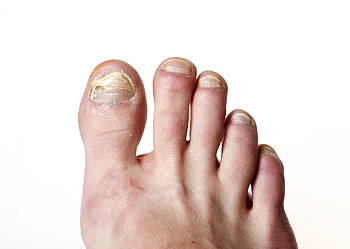 Researchers in Korea have found that excessive weight gain may lead to the unsightly condition known as onychomycosis, which is also referred to as toenail fungus. In patients who are diabetic, this condition may be painful and may lead to the development of additional infections. It may be beneficial to treat this ailment as early as possible and this may be accomplished by using a topical medicine. In more advanced cases, injections may be necessary to administer around the nail bed. Toenail fungus is typically not life-threatening, and there may be moderate symptoms that may accompany this condition. The most noticeable signs may be a thickening of the toenail, and may often appear black in color as the infection progresses. If you feel you have this condition, it’s advised to consult with a podiatrist who can recommend the best course of treatment for you.
Researchers in Korea have found that excessive weight gain may lead to the unsightly condition known as onychomycosis, which is also referred to as toenail fungus. In patients who are diabetic, this condition may be painful and may lead to the development of additional infections. It may be beneficial to treat this ailment as early as possible and this may be accomplished by using a topical medicine. In more advanced cases, injections may be necessary to administer around the nail bed. Toenail fungus is typically not life-threatening, and there may be moderate symptoms that may accompany this condition. The most noticeable signs may be a thickening of the toenail, and may often appear black in color as the infection progresses. If you feel you have this condition, it’s advised to consult with a podiatrist who can recommend the best course of treatment for you.
For more information about treatment, contact one of our podiatrists of Romeo Foot & Ankle Clinic. Our doctors can provide the care you need to keep you pain-free and on your feet.
Toenail Fungus Treatment
Toenail fungus is a condition that affects many people and can be especially hard to get rid of. Fortunately, there are several methods to go about treating and avoiding it.
Antifungals & Deterrence
Oral antifungal medicine has been shown to be effective in many cases. It is important to consult with a podiatrist to determine the proper regiment for you, or potentially explore other options.
Applying foot powder on the feet and shoes helps keep the feet free of moisture and sweat.
Sandals or open toed shoes – Wearing these will allow air movement and help keep feet dry. They also expose your feet to light, which fungus cannot tolerate. Socks with moisture wicking material also help as well.
If you have any questions please feel free to contact our offices located in Washington and Shelby Townships, MI . We offer the newest diagnostic tools and technology to treat your foot and ankle needs.
Toenail Fungus
Toenail fungus is a frustrating problem that affects many people. It can be persistent and hard to get rid of. As many different types of fungi are present throughout the environment, it is very easy to contract toenail fungus.
The feet are especially susceptible to toenail fungus because shoes and socks create the ideal dark and moist environment that fungal infections thrive in. While fungal infections of the nail plate are quite common, if left untreated they can spread beyond the toenail and into the skin and other parts of the body.
Signs of toenail fungus include a thickened nail that has become yellow or brown in color, a foul smell, and debris beneath the nail. The toe may become painful due to the pressure of a thicker nail or the buildup of debris.
Treatment for toenail fungus is most effective during the early stages of an infection. If there is an accumulation of debris beneath the nail plate, an ingrown nail or a more serious infection can occur. While each treatment varies between patients, your podiatrist may prescribe you oral medications, topical liquids and creams, or laser therapy. To determine the best treatment process for you, be sure to visit your podiatrist at the first signs of toenail fungus.
